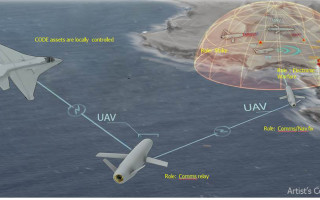DARPA to leverage open architectures, enabling UAS to fly as collaborative units
NewsJanuary 29, 2015

WASHINGTON. DARPA officials announced that the agency's Collaborative Operations in Denied Environment (CODE) program is offering the opportunity to participate in discussions to enable development of "groundbreaking" software that will allow unmanned aircraft to work together with minimal supervision.
According to a DARPA release most current ISR systems for unmanned aircraft systems (UASs) require constant control by a dedicated pilot and sensor operator plus a large number of analysts, all via telemetry. These control requirements severely constrain the scalability and cost-effectiveness of UAS operations and create operational challenges in dynamic, long-distance encounters with highly mobile targets in contested electromagnetic environments. (Photo courtesy of DARPA)
This DARPA program looks to overcome these challenges by designing algorithms and software that can extend the mission capabilities of existing unmanned aircraft well past the current state-of-the-art, with the goal of improving U.S. military ability to conduct operations in denied or contested airspace. CODE researchers are seeking to create a modular software architecture that will be resilient to bandwidth limitations and communications disruptions, while compatible with existing standards and capable of affordable retrofit into existing platforms.
DARPA officials released a Special Notice (http://go.usa.gov/JXFd) inviting any interested parties to identify their interest in participation in select Phase 1 CODE meetings. DARPA is particularly interested in participants that have capabilities, methodologies, and approaches related to CODE research and focused on revolutionary approaches to UASs, autonomy, and collaborative operations. Responses to the Special Notice will then be used to select the participants and should not contain intellectual, confidential, proprietary, or other privileged information.
Two meetings are planned at the moment -- an Open Architecture Meeting and a Technology Interchange Meeting. The Open Architecture Meeting will cover the requirements and approaches for making the CODE open architecture compatible with communication-constrained, distributed, highly autonomous collaborative systems. During the Technology Interchange Meeting, invited participants will present technologies that have potential for incorporation into the demonstration planned for Phases 2 and 3 of the program and ensure that CODE leverages the best available technologies from all possible sources.
The meetings are scheduled for the first week of March in the Arlington, Va., area. To be considered for attendance to the meetings, interested parties can submit a one-page response to DARPA by 4:00 PM Eastern Time on February 4, 2015. More information can be found at http://go.usa.gov/JXFd. All technical and administrative correspondence, including one-page responses and questions regarding this announcement, should be sent to DARPA-SN-15-20@darpa.mil.
CODE focuses on developing and demonstrating enhancements in collaborative autonomy: the capability for groups of UASs to work together under a single human commander’s supervision. The unmanned vehicles would then continuously evaluate themselves and their environment to present recommendations for UAV team actions to the mission supervisor who would approve, disapprove, or direct the team to collect more data. Using collaborative autonomy, CODE-enabled unmanned aircraft could find targets and engage them as appropriate under established rules of engagement, leverage nearby CODE-equipped systems with little supervision, and then adapt to dynamic situations such as attrition of friendly forces or the emergence of unanticipated threats.
CODE’s improvements would essentially enable UAS control systems to go from multiple human operators for each UAS to one person who is able to command and control six or more unmanned vehicles simultaneously.
“Just as wolves hunt in coordinated packs with minimal communication, multiple CODE-enabled unmanned aircraft would collaborate to find, track, identify and engage targets, all under the command of a single human mission supervisor,” says Jean-Charles Ledé, DARPA program manager. “Further, CODE aims to decrease the reliance of these systems on high-bandwidth communication and deep crew bench while expanding the potential spectrum of missions through combinations of assets—all at lower overall costs of operation. These capabilities would greatly enhance survivability and effectiveness of existing air platforms in denied environments.”







